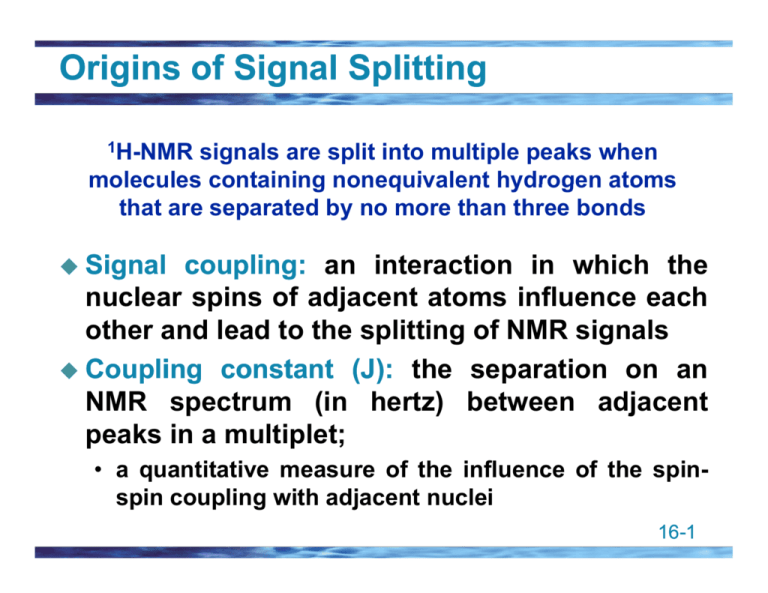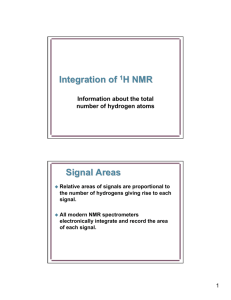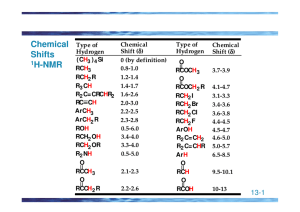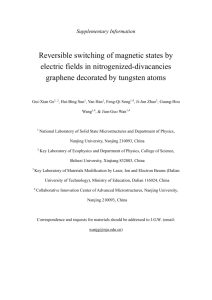Chapter 13 (part 2)
advertisement

Origins of Signal Splitting 1H-NMR signals are split into multiple peaks when molecules containing nonequivalent hydrogen atoms that are separated by no more than three bonds Signal Si l coupling: coupling li : an interaction i t ti i which in hi h the th nuclear spins of adjacent atoms influence each other and lead to the splitting of NMR signals Coupling constant (J) (J):: the separation on an NMR spectrum (in hertz) between adjacent peaks in a multiplet; • a quantitative measure of the influence of the spinspin coupling with adjacent nuclei 16--1 16 Origins of Signal Splitting 16--2 16 Origins of Signal Splitting • because splitting patterns from spectra taken at 300 MHz and higher are often difficult to see, it is common to retrace certain signals in expanded form • 1H-NMR spectrum of 3-pentanone; scale expansion shows the triplet quartet pattern more clearly 16--3 16 Coupling Constants Coupling constant (J): the distance between peaks in a split signal, expressed in hertz • the th value l is i a quantitative tit ti measure off the th magnetic ti interaction of nuclei whose spins are coupled Ha Ha Hb C C 6-8 Hz C C C Hb 11 18 H 11-18 Hz 0-5 Hz Hb Ha C H Hb a Hb Hb 8-14 Hz Ha Ha 5 10 H 5-10 Hz C 0-5 Hz Ha Ha Hb Hb C 0 5 Hz 0-5 8 11 H 8-11 Hz 16--4 16 Origins of Signal Splitting 16--5 16 Signal Splitting Pascal’s Triangle • as illustrated by the highlighted entries, each entry is the sum of the values immediately above it to the left and the right Careful with electronic noise that prevents distinguishing the smaller side peaks for a particular H with a signal of low intensity 16--6 16 Physical Basis for (n (n + 1) Rule Coupling of nuclear spins is mediated through intervening bonds • H atoms with more than three bonds between them generally do not exhibit noticeable coupling • for H atoms three bonds apart apart, the coupling is referred to as vicinal coupling 16--7 16 Coupling Constants • an important factor in vicinal coupling is the angle α between the C-H sigma bonds and whether or not it is fixed • coupling is a maximum when α is 0° and 180°; it is a minimum when α is 90° Bonds that rotate rapidly at RT do not have a fixed angle between adjacent C-H bonds: average angle and average coupling are observed 16--8 16 More Complex Splitting Patterns • thus far, we have concentrated on spin-spin coupling with only one other nonequivalent set of H atoms • more complex l splittings litti arise i when h a sett off H atoms t couples to more than one set H atoms • a tree diagram shows that when Hb is adjacent to nonequivalent Ha on one side and Hc on the other, the resulting coupling gives rise to a doublet of doublets 16--9 16 More Complex Splitting Patterns • if Hc is a set of two equivalent H, then the observed splitting is a doublet of triplets In the g general case,, a signal g will be split p into (n ( + 1)) x ((m + 1)) p peaks for an H atom coupled to a set of n H atoms with one coupling constant, and to a set of m H atoms with another coupling constant 16--10 16 More Complex Splitting Patterns • because the angle between C-H bond determines the extent of coupling, bond rotation is a key parameter • in i molecules l l with ith relatively l ti l free f rotation t ti about b t C-C CC sigma bonds, H atoms bonded to the same carbon in CH3 and CH2 groups generally are equivalent • if there is restricted rotation, as in alkenes and cyclic structures, H atoms bonded to the same carbon may not be equivalent • nonequivalent H on the same carbon will couple and cause signal g splitting p g • this type of coupling is called geminal coupling (J = 00-5 Hz) 16--11 16 More Complex Splitting Patterns • in ethyl propenoate, an unsymmetrical terminal alkene, the three vinylic hydrogens are nonequivalent 16--12 16 More Complex Splitting Patterns • a tree diagram for the complex coupling of the three vinylic hydrogens in ethyl propenoate 16--13 16 More Complex Splitting Patterns • cyclic structures often have restricted rotation about their C-C bonds and have constrained conformations • as a result, lt two t H atoms t on a CH2 group can be b nonequivalent, leading to complex splitting 16--14 16 More Complex Splitting Patterns • a tree diagram for the complex coupling in 2-methyl-2vinyloxirane 16--15 16 More Complex Splitting Patterns Complex coupling in flexible molecules • coupling in molecules with unrestricted bond rotation often gives only m + n + I peaks • that is, the number of peaks for a signal is the number b off adjacent dj h d hydrogens + 1, 1 no matter how h many different sets of equivalent H atoms that p represents • the explanation is that bond rotation averages the coupling constants throughout molecules with freely rotation bonds and tends to make them similar; similar for example in the 6- to 8-Hz range for H atoms on freely rotating sp3 hybridized C atoms 16--16 16 More Complex Splitting Patterns • simplification of signal splitting occurs when coupling constants are the same 16--17 16 More Complex Splitting Patterns • an example of peak overlap occurs in the spectrum of 1-chloro-3-iodopropane • the th central t l CH2 has h the th possibility ibilit for f 9 peaks k (a ( triplet ti l t of triplets) but because Jab and Jbc are so similar, only 4 + 1 = 5 peaks are distinguishable 16--18 16 More Complex Splitting Patterns Fast exchange: - Hydrogen atoms bonded to oxygen or nitrogen atoms can exchange with each other faster than the time it takes to acquire a 1H H-NMR NMR spectrum - Process facilitated by traces of acid or base - Consequences: a) Broad signals b) Signals will disappear when D2O or deuterated alcohol l h l is i added dd d Important affected functional groups: carboxylic acids, alcohols, amines, and amides 16--19 16 Stereochemistry & Topicity Depending on the symmetry of a molecule, otherwise equivalent hydrogens may be • homotopic • enantiotopic • diastereotopic di t t i The simplest way to visualize topicity is to substitute an atom or group by an isotope; is the resulting compound • the same as its mirror image • different from its mirror image possible • are diastereomers p 16--20 16 Stereochemistry & Topicity Homotopic H C H Cl Cl Dichloromethane (achiral) atoms or groups Substitute one H by D H Substitution does not produce a stereocenter; C Cl therefore hydrogens D are homotopic. Achiral Cl • homotopic atoms or groups have identical chemical shifts under all conditions 16--21 16 Stereochemistry & Topicity Enantiotopic H Cl C H F Chlorofluoromethane (achiral) groups Substitute one H by D Substitution produces a H t t stereocenter; Cl therefore, hydrogens are C F enantiotopic. Both hydrogens y g are prochiral; p ; D one is pro-R-chiral, the Chiral other is pro-S-chiral. • enantiotopic atoms or groups have identical chemical shifts in achiral environments • they have different chemical shifts in chiral environments (e.g. chiral solvents) 16--22 16 Stereochemistry & Topicity Diastereotopic groups • H atoms on C-3 of 2-butanol are diastereotopic • substitution by deuterium creates a chiral center • because there is already a chiral center in the molecule diastereomers are now possible molecule, H OH H H 2 Butanol 2-Butanol (chiral) Substitute one H on CH 2 by D H OH H D Chiral • diastereotopic hydrogens have different chemical shifts hift under d all ll conditions diti (can ( lead l d to t unexpected t d complexity in spectra of simple compounds) 16--23 16 Stereochemistry & Topicity The methyl groups on carbon 3 of 3-methyl-2butanol are diastereotopic • if a methyl hydrogen of carbon 4 is substituted by deuterium, a new chiral center is created • because there is already one chiral center center, diastereomers are now possible OH 3 Methyl 2 butanol 3-Methyl-2-butanol • protons of the methyl groups on carbon 3 have different chemical shifts 16--24 16 Stereochemistry and Topicity 1H-NMR spectrum of 3-methyl-2-butanol • the methyl groups on carbon 3 are diastereotopic and appear as two t doublets d bl t 16--25 16 13C-NMR Spectroscopy abundance of 13C (1.1%) results in weak signals Magnetic M ti momentt off 13C is i much h smaller ll than th that of 1H Each nonequivalent 13C gives a different signal Low • a 13C signal is split by the 1H bonded to it according to the (n + 1) rule • coupling constants of 100-250 Hz are common, which means that there is often significant overlap between signals, g , and splitting p gp patterns can be very y difficult to determine most common mode of operation of a 13CNMR spectrometer is a hydrogen-decoupled hydrogen decoupled mode The 16--26 16 13C-NMR Spectroscopy In a hydrogen-decoupled mode, a sample is irradiated with two different radio frequencies • one to excite all 13C nuclei • a second broad spectrum of frequencies to cause all hydrogens in the molecule to undergo rapid transitions between their nuclear spin states the time scale of a 13C C-NMR NMR spectrum, each hydrogen is in an average or effectively constant nuclear spin state, with the result that 1H-13C spin-spin interactions are not observed; they are decoupled On 16--27 16 13C-NMR Spectroscopy • hydrogen-decoupled 13C-NMR spectrum of 1bromobutane Caution: integration of signals is not reliable in 13C NMR spectroscopy (long relaxation times) 16--28 16 Chemical Shift - 13C-NMR Typ e of Carbon Chemical S hift (δ) RCH3 RCH2 R 10-40 15-55 20-60 20 60 R3 CH Type of Carb on C R Chemical Sh ift ((δ)) 110-160 O RCOR 160 - 180 RCH2 Cl 25-65 35 80 35-80 O RCNR2 165 - 180 R3 COH 40-80 R3 COR 40-80 65-85 O RCCOH 165 - 185 O O RCH, RCR 180 - 215 RCH2 I RCH2 Br RC CR R2 C=CR2 0-40 100-150 16--29 16 Chemical Shift - 13C-NMR 16--30 16 The DEPT Method In the hydrogen-decoupled mode, information on spin-spin spin spin coupling between 13C and hydrogens bonded to it is lost The DEPT method is an instrumental mode that provides a way to acquire this information • Distortionless Enhancement by Polarization Transfer (DEPT): DEPT): an NMR technique for distinguishing among 13C signals for CH , CH , CH, and quaternary carbons 3 2 16--31 16 The DEPT Method The DEPT methods uses a complex series of pulses in both the 1H and 13C ranges, with the result that CH3, CH2, and CH signals exhibit different phases; • signals i l for f CH3 and d CH carbons b are recorded d d as positive signals • s signals g a s for o C CH2 ca carbons bo s a are e recorded eco ded as negative egat e signals • quaternary carbons give no signal in the DEPT method th d 16--32 16 Isopentyl acetate • 13C-NMR: (a) proton decoupled and (b) DEPT 16--33 16 Interpreting NMR Spectra Alkanes • 1H-NMR signals appear in the range of δ 0.8-1.7 • 13C-NMR signals appear in the considerably wider range of δ 10-60 Alkenes Alk • 1H-NMR signals appear in the range δ 4.6-5.7 • 1H-NMR H NMR coupling constants are generally larger for trans vinylic hydrogens (J= 11-18 Hz) compared with cis vinylic hydrogens (J= 5-10 Hz) • 13C-NMR signals for sp2 hybridized carbons appear in the range δ 100-160, which is downfield from the signals of sp3 hybridized carbons 16--34 16 Interpreting NMR Spectra • 1H-NMR spectrum of vinyl acetate (Fig 13.31) 16--35 16 Interpreting NMR Spectra Alcohols 1H-NMR O-H chemical shifts often appears pp in the range δ 3.0-4.0, but may be as low as δ 0.5. • 1H-NMR chemical shifts of hydrogens on the carbon b i the bearing th -OH OH group are deshielded d hi ld d by b the th electronl t withdrawing inductive effect of the oxygen and appear in the range g δ 3.0-4.0 Ethers • a distinctive feature in the 1H-MNR spectra of ethers is the chemical shift, δ 3.3-4.0, of hydrogens on carbon attached to the ether oxygen 16--36 16 Interpreting NMR Spectra • 1H-NMR spectrum of 1-propanol (Fig. 13.32) 16--37 16 Interpreting NMR Spectra Aldehydes and ketones • 1H-NMR: aldehyde hydrogens appear at δ 9.5-10.1 • 1H-NMR: α-hydrogens of aldehydes and ketones appear at δ 2.2-2.6 • 13C-NMR: C NMR: carbonyl carbons appear at δ 180-215 180 215 Amines • 1H H-NMR: NMR: amine hydrogens appear at δ 0.5-5.0 0550 depending on conditions 16--38 16 Interpreting NMR Spectra Carboxylic C b li acids id • 1H-NMR: carboxyl hydrogens appear at δ 10-13, lower than most any other hydrogens • 13C-NMR: carboxyl carbons in acids and esters appear at δ 160-180 16--39 16 Interpreting NMR Spectra Spectral Problem 1; molecular formula C5H10O 16--40 16 Interpreting NMR Spectra Spectral Problem 2; molecular formula C7H14O 16--41 16








